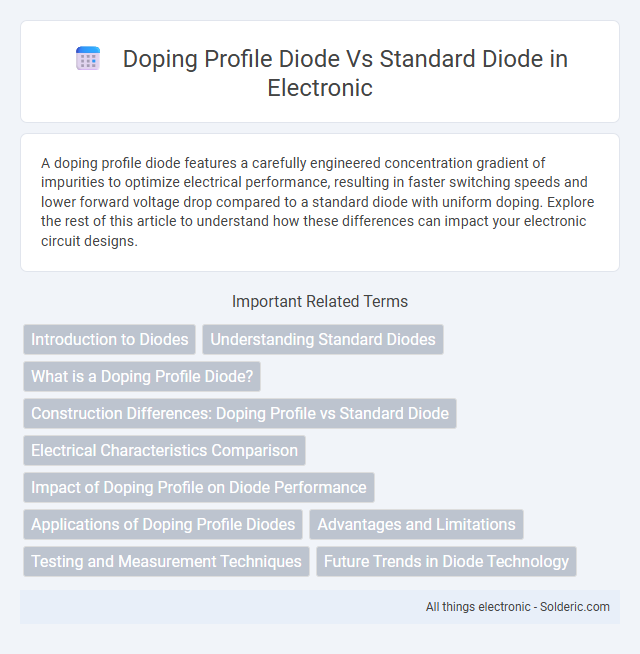A doping profile diode features a carefully engineered concentration gradient of impurities to optimize electrical performance, resulting in faster switching speeds and lower forward voltage drop compared to a standard diode with uniform doping. Explore the rest of this article to understand how these differences can impact your electronic circuit designs.
Comparison Table
| Feature | Doping Profile Diode | Standard Diode |
|---|---|---|
| Junction Type | Graded or abrupt doping profile for optimized performance | Typically abrupt PN junction |
| Performance | Enhanced switching speed and efficiency | Standard switching speed and efficiency |
| Leakage Current | Lower leakage current due to optimized doping | Higher leakage current |
| Breakdown Voltage | Controlled breakdown voltage through doping gradients | Fixed breakdown voltage based on material and junction |
| Applications | High-speed switching, RF circuits, precision applications | General-purpose rectification and switching |
| Cost | Higher due to advanced doping techniques | Lower manufacturing cost |
Introduction to Diodes
Doping profiles in diodes significantly influence their electrical characteristics, where a standard diode typically uses a uniformly doped p-n junction, resulting in predictable forward voltage and breakdown properties. In contrast, doping profile diodes feature engineered variations in impurity concentration across the junction, optimizing parameters such as switching speed, leakage current, and breakdown voltage. These controlled doping gradients enable specialized performance tailored for high-frequency applications and enhanced reliability compared to standard diodes.
Understanding Standard Diodes
Standard diodes typically use a p-n junction formed by doping silicon with acceptor (p-type) and donor (n-type) impurities to create a charge barrier allowing current flow in one direction. The doping profile directly influences key parameters such as forward voltage drop, reverse recovery time, and leakage current. Understanding these fundamental characteristics helps optimize diode performance in rectification and signal modulation applications.
What is a Doping Profile Diode?
A doping profile diode features a carefully engineered gradient of dopants within its semiconductor material, enhancing performance characteristics like switching speed and breakdown voltage compared to a standard diode with uniform doping. This tailored doping profile reduces charge storage and minimizes recombination, resulting in improved efficiency and faster response in high-frequency applications. Understanding your diode's doping profile is crucial for selecting components that meet specific electrical and thermal requirements in advanced electronic circuits.
Construction Differences: Doping Profile vs Standard Diode
The doping profile of a diode significantly influences its electrical characteristics and construction compared to a standard diode. In a doping profile diode, the doping concentration varies gradually across the junction, creating a graded region that enhances charge carrier flow and reduces junction capacitance. Your choice of a doping profile diode offers improved performance in high-frequency and high-speed switching applications, whereas a standard diode typically features abrupt doping levels with a sharp pn-junction optimized for general-purpose rectification.
Electrical Characteristics Comparison
Doping profile diodes exhibit superior electrical characteristics compared to standard diodes, including lower forward voltage drop and faster switching speeds due to optimized impurity concentration gradients. The tailored doping creates a sharper junction, enhancing carrier injection efficiency and reducing junction capacitance, which improves overall diode response time. These improvements result in higher efficiency and better performance in high-frequency and power-sensitive applications.
Impact of Doping Profile on Diode Performance
The doping profile significantly influences diode performance by affecting key parameters such as junction capacitance, breakdown voltage, and forward conduction characteristics. Graded doping profiles result in smoother electric field distribution, enhancing breakdown voltage and reducing leakage current compared to abrupt junction diodes. Optimized doping gradients improve switching speed and reduce power loss, making them suitable for high-frequency and power-efficient applications.
Applications of Doping Profile Diodes
Doping profile diodes, characterized by tailored impurity gradients, exhibit superior performance in high-frequency and high-speed switching applications compared to standard diodes with uniform doping. Their precise doping enables enhanced charge carrier control, making them ideal for RF circuits, microwave devices, and fast recovery rectifiers. These specialized diodes are essential in power electronics, signal modulation, and communication systems where efficiency and speed are critical.
Advantages and Limitations
Doping profile diodes offer higher speed and improved switching performance compared to standard diodes due to tailored impurity concentrations that reduce charge storage and enhance carrier mobility. These diodes exhibit lower forward voltage drops and reduced reverse recovery times, making them ideal for high-frequency applications, but their complex manufacturing process can increase costs. Your choice depends on whether enhanced efficiency and speed outweigh the economic trade-offs in your specific electronic design.
Testing and Measurement Techniques
Doping profile diodes require advanced testing and measurement techniques like Secondary Ion Mass Spectrometry (SIMS) and Spreading Resistance Profiling (SRP) to accurately analyze their dopant concentration and distribution, unlike standard diodes that often rely on simpler electrical characterization such as IV curves and capacitance-voltage (C-V) measurements. Precise doping profile analysis ensures improved device performance and reliability by identifying variations at the microscopic level, which standard diode tests may overlook. Your choice of measurement method significantly affects the accuracy of diode parameter assessment and optimization in semiconductor applications.
Future Trends in Diode Technology
Doping profile diodes offer enhanced control over electrical characteristics, leading to faster switching speeds and lower power losses compared to standard diodes. Future trends in diode technology emphasize the integration of advanced doping techniques, such as graded or hyper-doping profiles, to improve efficiency in high-frequency and high-power applications. Emerging materials and precise doping control are key to developing next-generation diodes with superior performance in power electronics and communication systems.
Doping profile diode vs Standard diode Infographic

 solderic.com
solderic.com